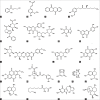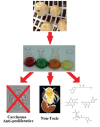High Performance Liquid Chromatography-mass Spectrometry Analysis of High Antioxidant Australian Fruits with Antiproliferative Activity Against Cancer Cells
- PMID: 27279705
- PMCID: PMC4883077
- DOI: 10.4103/0973-1296.182178
High Performance Liquid Chromatography-mass Spectrometry Analysis of High Antioxidant Australian Fruits with Antiproliferative Activity Against Cancer Cells
Abstract
Background: High antioxidant capacities have been linked to the treatment and prevention of several cancers. Recent reports have identified several native Australian fruits with high antioxidant capacities. Despite this, several of these species are yet to be tested for anticancer activity.
Materials and methods: Solvent extracts prepared from high antioxidant native Australian fruits were analyzed for antioxidant capacity by the di (phenyl)-(2,4,6-trinitrophenyl) iminoazanium free radical scavenging assay. Antiproliferative activities against CaCo2 and HeLa cancer cells were determined by a multicellular tumor spheroid-based cell proliferation assay. Toxicity was determined by Artemia franciscana bioassay.
Results: Methanolic extracts of all plant species displayed high antioxidant contents (equivalent to approximately 7-16 mg of vitamin C per gram of fruit extracted). Most aqueous extracts also contained relatively high antioxidant capacities. In contrast, the ethyl acetate, chloroform, and hexane extracts of most species (except lemon aspen and bush tomato) had lower antioxidant contents (below 1.5 mg of vitamin C equivalents per gram of plant material extracted). The antioxidant contents correlated with the ability of the extracts to inhibit proliferation of CaCo2 and HeLa cancer cell lines. The high antioxidant methanolic extracts of all species were potent inhibitors of cell proliferation. The methanolic lemon aspen extract was particularly effective, with IC50 values of 480 and 769 μg/mL against HeLa and CaCo2 cells, respectively. In contrast, the lower antioxidant ethyl acetate and hexane extracts (except the lemon aspen ethyl acetate extract) generally did not inhibit cancer cell proliferation or inhibited to only a minor degree. Indeed, most of the ethyl acetate and hexane extracts induced potent cell proliferation. The native tamarind ethyl acetate extract displayed low-moderate toxicity in the A. franciscana bioassay (LC50 values below 1000 μg/mL). All other extracts were nontoxic. A total of 145 unique mass signals were detected in the lemon aspen methanolic and aqueous extracts by nonbiased high-performance liquid chromatography-mass spectrometry analysis. Of these, 20 compounds were identified as being of particular interest due to their reported antioxidant and/or anticancer activities.
Conclusions: The lack of toxicity and antiproliferative activity of the high antioxidant plant extracts against HeLa and CaCo2 cancer cell lines indicates their potential in the treatment and prevention of some cancers.
Summary: Australian fruit extracts with high antioxidant contents were potent inhibitors of CaCo2 and HeLa carcinoma cell proliferationMethanolic lemon aspen extract was particularly potent, with IC50 values of 480 μg/mL (HeLa) and 769 μg/mL (CaCo2)High-performance liquid chromatography-mass spectrometry-quadrupole time-of-flight analysis highlighted and putatively identified 20 compounds in the antiproliferative lemon aspen extractsIn contrast, lower antioxidant content extracts stimulated carcinoma cell proliferationAll extracts with antiproliferative activity were nontoxic in the Artemia nauplii assay. Abbreviations used: DPPH: di (phenyl)- (2,4,6-trinitrophenyl) iminoazanium, HPLC: High-performance liquid chromatography, IC50: The concentration required to inhibit by 50%, LC50: The concentration required to achieve 50% mortality, MS: Mass spectrometry.
Keywords: Anticancer activity; Illawarra plum; bush tomato; desert lime; functional foods; lemon aspen; muntries; native tamarind.
Figures








References
-
- Seifried HE, Anderson DE, Fisher EI, Milner JA. A review of the interaction among dietary antioxidants and reactive oxygen species. J Nutr Biochem. 2007;18:567–79. - PubMed
-
- McCord JM, Fridovich I. The biology and pathology of oxygen radicals. Ann Intern Med. 1978;89:122–7. - PubMed
-
- Sirdaarta J, Cock IE. Effect of Aloe barbadensis Miller juice on oxidative stress biomarkers in aerobic cells using Artemia franciscana as a model. Phytother Res. 2010;24:360–4. - PubMed
-
- Tome ME, Baker AF, Powis G, Payne CM, Briehl MM. Catalase-overexpressing thymocytes are resistant to glucocorticoid-induced apoptosis and exhibit increased net tumor growth. Cancer Res. 2001;61:2766–73. - PubMed
LinkOut - more resources
Full Text Sources
Other Literature Sources
Research Materials
